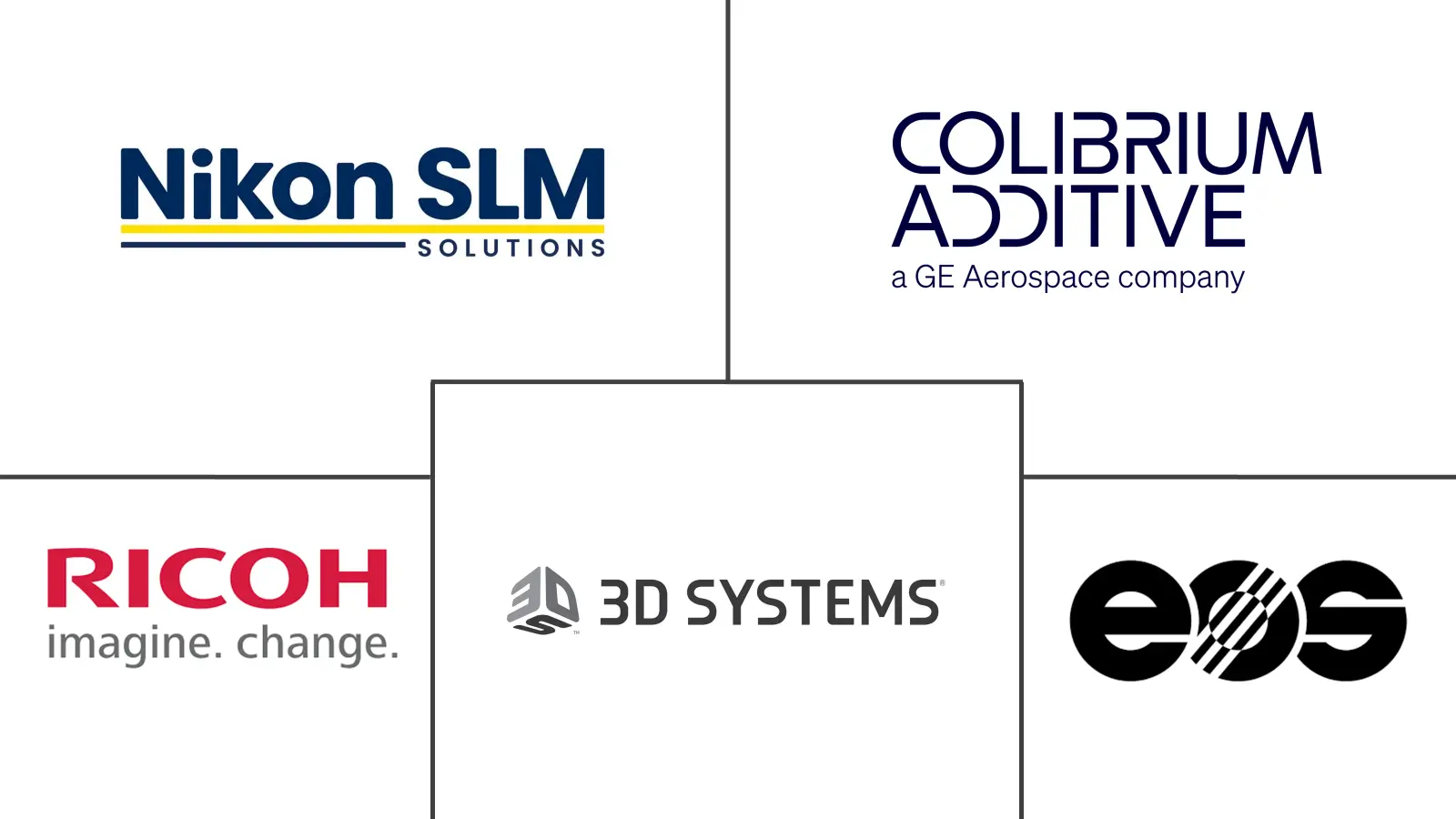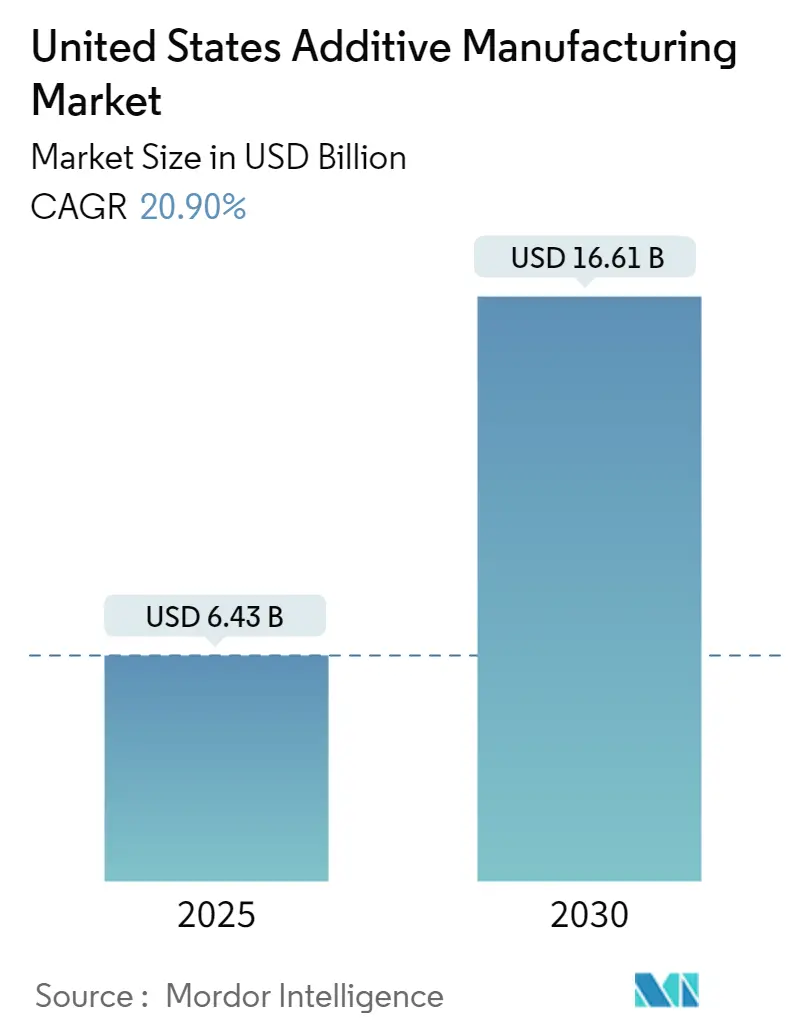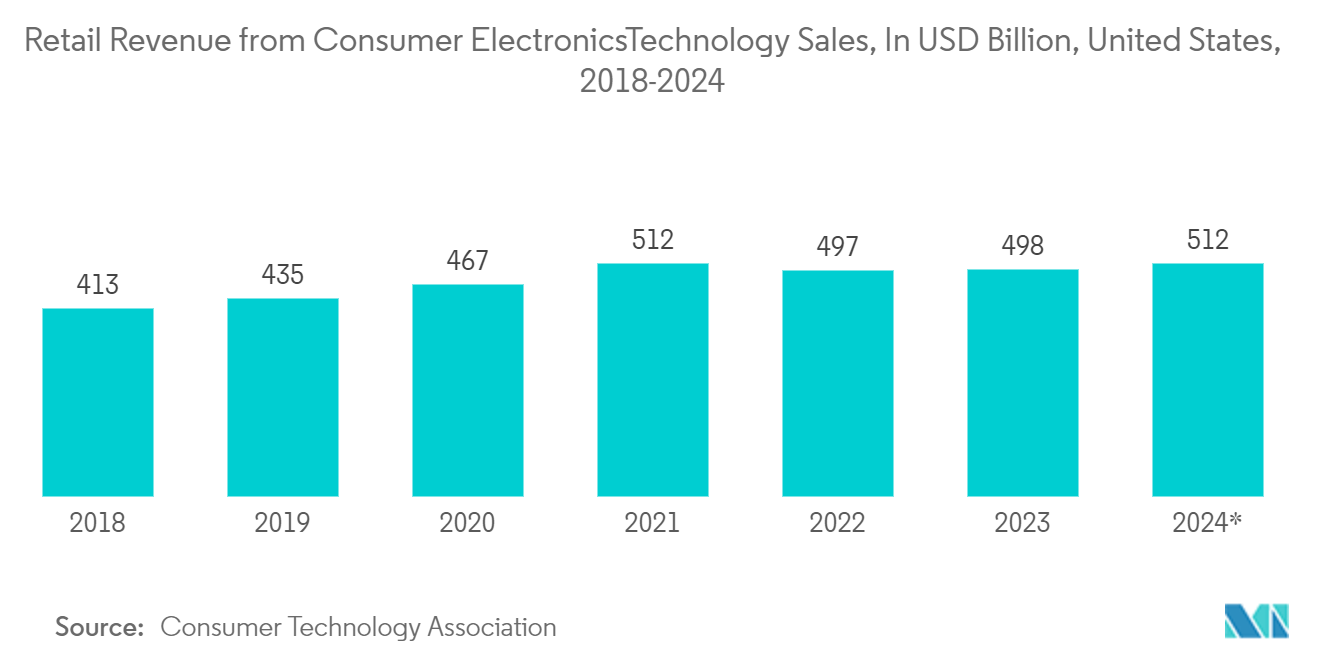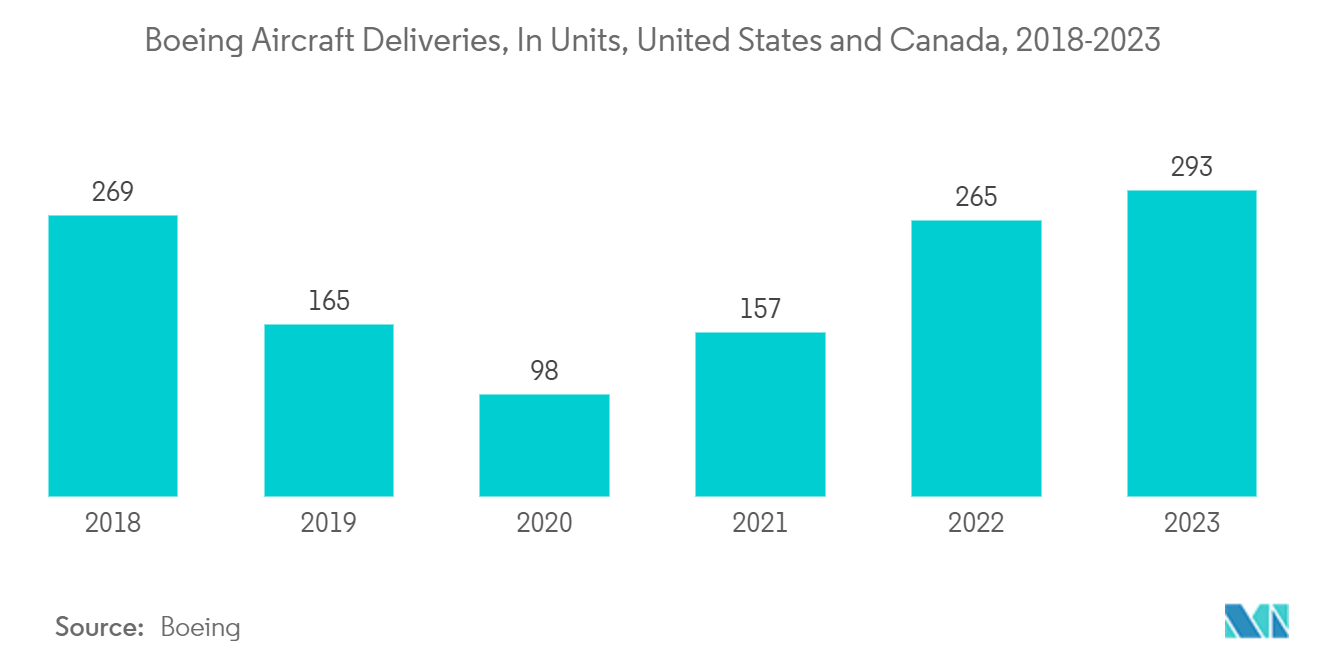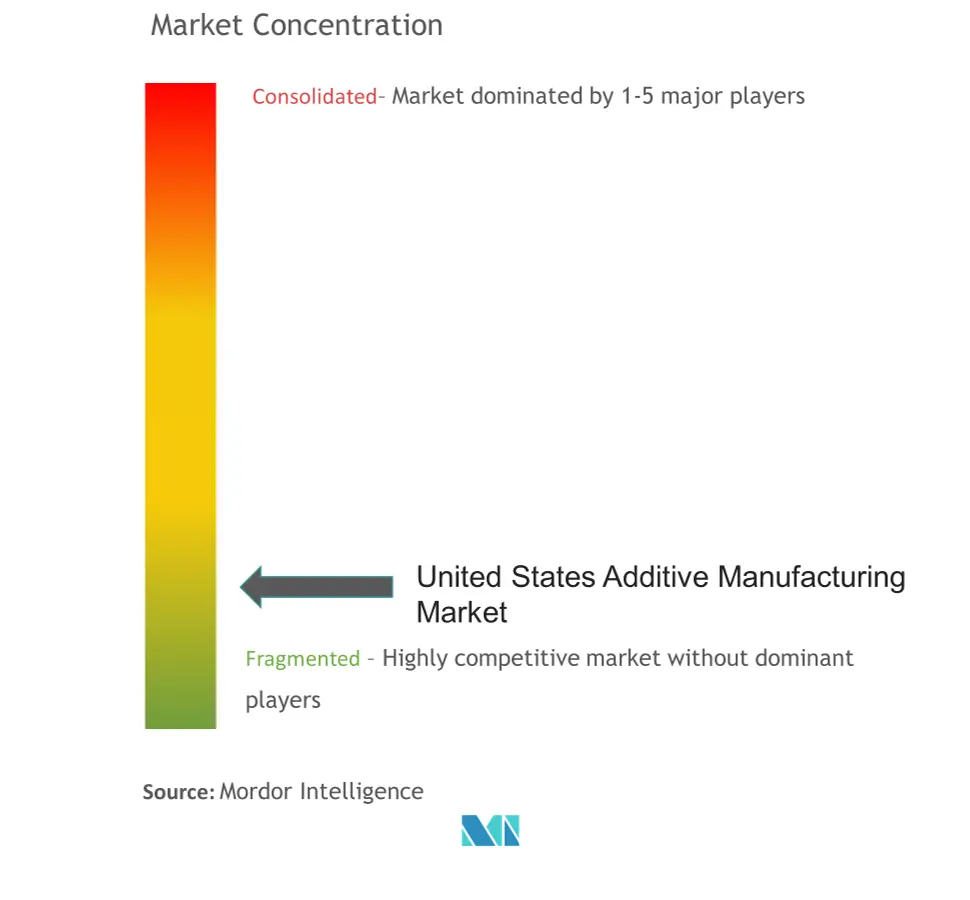United States Additive Manufacturing Market Analysis
The United States Additive Manufacturing Market size is estimated at USD 6.43 billion in 2025, and is expected to reach USD 16.61 billion by 2030, at a CAGR of 20.9% during the forecast period (2025-2030).
- Additive manufacturing, commonly known as 3D printing, transforms the production, design, and performance of innovative architectural forms, construction systems, and materials. This automated technology creates rapid prototypes and produces functional end-use parts. By leveraging computer-aided design (CAD) software, virtual designs are converted into thin, horizontal layer-wise cross-sections, resulting in a complete model.
- With rapid advancements in material compositions, particularly the increasing applications of polymers and metals, additive manufacturing is evolving from a prototyping tool to a critical component of fabrication. The introduction of new materials, shorter lead times, and innovative finishes while adhering to FDA, ASTM, and ISO standards are enabling the seamless integration of this technology into mainstream manufacturing processes.
- Furthermore, the decreasing prices of additive manufacturing machines, combined with growing expertise and awareness, have significantly increased the accessibility of this technology. Recent advancements in fused deposition modeling techniques have expanded the range of usable materials, greatly enhancing its adoption across various industries.
- A wider adoption of this technology was observed across multiple sectors as manufacturers brought an increased number of industrial solutions to the market. Similarly, interoperability among different industrial systems drives the demand for 3D printing and additive manufacturing. Furthermore, automation in the production process and post-processing further drives the market. For instance, HP is working with Volkswagen to 3D print parts at a large scale. Volkswagen installed 90 HP 3D printers in its factories and produced 10,000 parts in a few weeks.
- The initial investment required for additive manufacturing equipment is substantial. High-quality 3D printers, especially those capable of producing industrial-grade parts, often have a hefty price tag. This can deter smaller companies or startups from adopting the technology, limiting the market's growth.
- The ongoing conflict between Russia and Ukraine has had significant repercussions on the additive manufacturing market. The war has disrupted supply chains, particularly for raw materials and components essential for additive manufacturing. Ukraine is a major supplier of semiconductor-grade neon, which is critical for laser-based 3D printing technologies. The conflict has led to shortages and increased costs for these materials, making it challenging for manufacturers to maintain production levels and meet demand.
United States Additive Manufacturing Market Trends
The Selective Laser Sintering Segment is Expected to Hold a Significant Share of the Market
- Selective laser sintering (SLS) is a 3D printing process (Additive Manufacturing) that utilizes high-powered lasers to sinter or bind finely powdered material into a solid structure. In this process, a printer lays down an even layer of powder and precisely sinters that layer, repeating the deposition and sintering process until the part is complete. The object's shape is formed by aiming a laser at the powder bed at specific points in space, guided by a digitally produced CAD (computer-aided design) file.
- Selective Laser Sintering (SLS) is recognized as a leading technology and is anticipated to experience substantial growth during the forecast period due to its numerous advantages over other printing technologies. SLS uses nylon powder instead of the photosensitive resin utilized in stereolithography. Companies and research organizations across the United States are capitalizing on this material and technology to address issues such as the resin's brittleness when exposed to sunlight.
- Additionally, SLS is cost-effective and material-efficient, as it does not require dedicated support structures post-printing. It also offers enhanced durability, making it suitable for functional parts and prototypes. SLS finds extensive applications across various sectors, including aerospace, defense, and automotive. With the paradigm shift in space exploration, the demand for SLS printing is expected to increase as more countries are prepared to launch satellites.
- Moreover, numerous aerospace companies are adopting SLS technology to enhance production efficiency. For instance, in the space flight sector, NASA and private companies are developing rocket engines (and even entire rockets, as in the case of Relativity Space) with fewer parts, leveraging 3D printing to reduce production time and costs.
- The SLS technique offers several benefits, including printing multiple parts as a single unified component in just days and reducing the rocket's weight by minimizing the use of nuts, bolts, and welds. If a test reveals a fault in the rocket, modifications can be made quickly in the 3D modeling software, allowing for a rapid setup of another test. Also, SLS enables the production of customized parts tailored to specific consumer needs. This is especially relevant in the electronics market, where personalization is increasingly valued. Companies can create enclosures or components that fit unique specifications, catering to niche markets or individual customer preferences.
- The increasing sales of consumer electronics are significantly driving the growth of SLS technology. As the demand for innovative and customized electronic products rises, manufacturers are increasingly turning to SLS technology to meet these needs. According to the Consumer Technology Association, based on the projected retail sales for 2024, retail sales of consumer electronics in the United States are expected to reach USD 512 billion. Such an increase is expected to boost the market's growth during the forecast period.
The Aerospace and Defense Industry is Expected to Have a Significant Growth in the Market
- The advancement of aerospace materials processing has been motivated by the relentless pursuit of lighter, stronger, and more resilient materials. Additive manufacturing is becoming prevalent in the aerospace sector and utilized for various purposes. Whether it be intricate turbine blades, lightweight structural elements, or cabin fixtures, additive manufacturing is making a significant impact in aerospace. Engine components are among the most prominent examples of additive manufacturing applications in this industry.
- Also, additive manufacturing in the aerospace industry has brought about a revolutionary change in the way products are conceived, designed, and manufactured. This change is particularly evident in the aerospace sector. The possibilities for utilizing additive manufacturing in aerospace are extensive, ranging from enhancing the weight and strength of existing components to developing completely novel designs that were once considered unattainable using conventional manufacturing techniques. As a result, numerous companies are substantially bolstering their market position within this industry.
- In April 2024, Relativity Space obtained a USD 8.7 million contract with the US Air Force Research Laboratory (AFRL). The objective of this two-year research contract, facilitated by AFRL's Materials and Manufacturing Directorate at Wright-Patterson Air Force Base in Ohio, is to delve into real-time flaw detection in additive manufacturing. This technology holds significant importance as additive manufacturing involves the deposition of thin layers of material, with each layer contributing to the likelihood of imperfections.
- Additive manufacturing in the aerospace industry is transforming the production of aircraft components and bringing forth a more environmentally friendly approach to manufacturing. Traditional methods often result in a considerable amount of material being discarded as scraps and off-cuts.
- The rising demand for aircraft and the subsequent increase in aircraft deliveries are expected to significantly boost the market for additive manufacturing. As airlines and manufacturers strive to enhance fuel efficiency and reduce operational costs, there is a strong push for lightweight aircraft components. According to Boeing, in 2023, the company delivered 293 aircraft in the United States and Canada, 28 units more than the last year.
- However, 3D printing, due to its inherent nature, optimizes material usage by employing it only where necessary, leading to a substantial reduction in waste. This, in turn, results in significant savings on raw materials, particularly when utilizing costly aerospace-grade materials. Therefore, the "Green Advantage" factor is expected to be one of the significant benefits of additive manufacturing in the aerospace industry.
United States Additive Manufacturing Industry Overview
The US additive manufacturing market is highly fragmented, with global conglomerates and specialized players operating across various segments. While several large multinational companies dominate certain high-value segments, numerous regional and niche players contribute to the overall competition, making the market highly diverse. This fragmentation is driven by the wide range of applications for additive manufacturing, allowing both large and small companies to coexist and thrive in the market.
Leading companies in the US additive manufacturing market include 3D Systems Corporation, General Electric Company (GE Additive), and EnvisionTEC GmbH. These companies have established strong brand recognition and extensive global operations, enabling them to command a significant market share. Their strengths are in innovation, broad product portfolios, and strong distribution networks. These leaders often engage in strategic acquisitions and partnerships to maintain their competitive edge and expand their market reach.
To succeed in the US additive manufacturing market, companies must prioritize innovation. Additionally, expanding product offerings and enhancing customer support will be crucial for maintaining long-term relationships and securing repeat business. Companies that invest in emerging markets and adapt their products to regional needs are likely to gain a competitive advantage in this fragmented market.
United States Additive Manufacturing Market Leaders
-
3D Systems Corporation
-
General Electric Company (GE Additive)
-
Nikon SLM
-
Ricoh USA Inc.
-
EOS GmbH
- *Disclaimer: Major Players sorted in no particular order
United States Additive Manufacturing Market News
- June 2024: Nikon SLM Solutions AG commenced the production of its NXG XII 600 metal Additive Manufacturing machine in the United States. The expansion of its manufacturing capabilities provides North American customers with a fully ‘American Made’ metal AM machine. The manufacturing unit has the ability to meet the increasing demand for its metal additive manufacturing solutions across key industries, including aerospace, defense, automotive, and energy.
- June 2024: Ricoh USA Inc. announced the launch of its fully managed on-site 3D printing solution, RICOH All-In 3D Print. Designed to streamline the production of 3D-printed product prototypes and other additive manufacturing uses, this complete XaaS solution for additive manufacturing includes necessary components, such as printing hardware, advanced 3D production software, specialized Ricoh labor, and essential supplies to propel businesses’ manufacturing capabilities forward with the power of rapid prototyping.
- April 2024: Meltio, a 3D printer manufacturer, and Accufacture, a Michigan-based industrial automation company, introduced the Alchemist 1, a new large-scale robotic DED 3D printing work cell made in the United States. Powered by Meltio’s laser metal deposition (LMD) 3D printing technology, Alchemist 1 is optimized for producing large-scale, fully dense metal parts. The robotic additive manufacturing work cell is also designed to be easily integrated into existing production lines.
United States Additive Manufacturing Industry Segmentation
In contrast to traditional subtractive methods that remove material from a solid block, additive manufacturing constructs 3D objects by adding material layer by layer. The study tracks the revenue accrued through the sale of additive manufacturing components in the US market by various players. The study also tracks the key market parameters, underlying growth influencers, and major vendors operating in the industry, which supports the market estimations and growth rates during the forecast period.
The US additive manufacturing market is segmented by component (hardware [desktop 3d printer and industrial 3d printer], software [design software, inspection software, printing software, and scanning software], and services), material (polymer, metal, and ceramic), technology (stereo lithography, selective laser sintering, fused deposition modeling, laser sintering, binder jetting printer, and other technologies), and end-user vertical (automotive, aerospace and defense, healthcare, consumer electronics, power and energy, fashion and jewelry, dentistry, and other end-user verticals). The market sizes and forecasts are provided in terms of value (USD) for all the above segments.
| By Component | Hardware | Desktop 3D Printer | |
| Industrial 3D Printer | |||
| Software | Design Software | ||
| Inspection Software | |||
| Printer Software | |||
| Scanning Software | |||
| Services | |||
| By Material | Polymer | ||
| Metal | |||
| Ceramic | |||
| By Technology | Stereo Lithography | ||
| Selective Laser Sintering | |||
| Fused Deposition Modelling | |||
| Laser Sintering | |||
| Binder Jetting Printing | |||
| Other Technologies | |||
| By End-user Vertical | Automotive | ||
| Aerospace and Defense | |||
| Healthcare | |||
| Consumer Electronics | |||
| Power and Energy | |||
| Fashion and Jewelry | |||
| Dentistry | |||
| Other End-user Verticals | |||
United States Additive Manufacturing Market Research FAQs
How big is the United States Additive Manufacturing Market?
The United States Additive Manufacturing Market size is expected to reach USD 6.43 billion in 2025 and grow at a CAGR of 20.90% to reach USD 16.61 billion by 2030.
What is the current United States Additive Manufacturing Market size?
In 2025, the United States Additive Manufacturing Market size is expected to reach USD 6.43 billion.
Who are the key players in United States Additive Manufacturing Market?
3D Systems Corporation, General Electric Company (GE Additive), Nikon SLM, Ricoh USA Inc. and EOS GmbH are the major companies operating in the United States Additive Manufacturing Market.
What years does this United States Additive Manufacturing Market cover, and what was the market size in 2024?
In 2024, the United States Additive Manufacturing Market size was estimated at USD 5.09 billion. The report covers the United States Additive Manufacturing Market historical market size for years: 2019, 2020, 2021, 2022, 2023 and 2024. The report also forecasts the United States Additive Manufacturing Market size for years: 2025, 2026, 2027, 2028, 2029 and 2030.
United States Additive Manufacturing Industry Report
Statistics for the 2025 United States Additive Manufacturing market share, size and revenue growth rate, created by Mordor Intelligence™ Industry Reports. United States Additive Manufacturing analysis includes a market forecast outlook for 2025 to 2030 and historical overview. Get a sample of this industry analysis as a free report PDF download.

